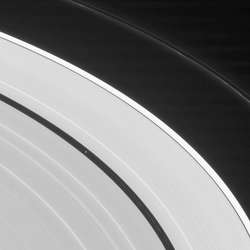
Moon Pan behind ring A. Image credit: NASA/JPL/SSI Click to enlarge
Cassini turns its gaze toward Saturn’s outer A ring to find the moon Pan coasting behind one of the thin ringlets which it shares with the Encke Gap. Pan is 26 kilometers (16 miles) across.
Understanding the influence of Saturn’s moons on its immense ring system is one of the goals of the Cassini mission. The study of the icy rings includes the delicate and smoky-looking F ring, seen here toward the upper right. The F ring exhibits bright kinks and multiple strands here.
Arching across the center of the scene, the outermost section of the A ring is notably brighter than the ring material interior to it.
The image was taken in visible light with the Cassini spacecraft narrow-angle camera on Aug. 13, 2005, at a distance of approximately 2.3 million kilometers (1.5 million miles) from Saturn. The image scale is 14 kilometers (9 miles) per pixel on Pan.
The Cassini-Huygens mission is a cooperative project of NASA, the European Space Agency and the Italian Space Agency. The Jet Propulsion Laboratory, a division of the California Institute of Technology in Pasadena, manages the mission for NASA’s Science Mission Directorate, Washington, D.C. The Cassini orbiter and its two onboard cameras were designed, developed and assembled at JPL. The imaging operations center is based at the Space Science Institute in Boulder, Colo.
For more information about the Cassini-Huygens mission visit http://saturn.jpl.nasa.gov . The Cassini imaging team homepage is at http://ciclops.org .
Original Source: NASA/JPL/SSI News Release
